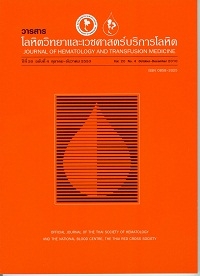ความชุกของโรคโลหิตจางจากการขาดธาตุเหล็กในผู้สูงอายุที่มีโลหิตจาง และภาวะของธาตุเหล็กในผู้สูงอายุ
Keywords:
โลหิตจาง, ภาวะขาดธาตุเหล็ก, โลหิตจางจากการขาดธาตุเหล็ก, Anemia, Iron deficiency, Iron deficiency anemia, Iron statusAbstract
บทคัดย่อ
ภาวะโลหิตจางนับเป็นปัญหาสำคัญทั่วโลกรวมทั้งในประเทศไทย โลหิตจางจากการขาดธาตุเหล็กเป็นสาเหตุของโลหิตจางที่พบบ่อย มีการศึกษาที่กล่าวถึงภาวะโลหิตจางจากการขาดธาตุเหล็ก โดยพบว่ามีความชุกตั้งแต่ร้อยละ 12 ถึง ร้อยละ 47 ทั้งนี้ขึ้นอยู่กับกลุ่มประชากรที่ศึกษา วัตถุประสงค์ : เพื่อศึกษาความชุกของภาวะโลหิตจางจากการขาดธาตุเหล็กในประชากรผู้สูงอายุ และปัจจัยที่มีผลต่อระดับธาตุเหล็กหรือภาวะโลหิตจางจากการขาดธาตุเหล็กในผู้สูงอายุ วิธีการศึกษา : ศึกษาโดยเก็บข้อมูลแบบไปข้างหน้าที่หน่วยตรวจอายุรกรรม โรงพยาบาลธรรมศาสตร์เฉลิมพระเกียรติในผู้ป่วยอายุมากกว่า 60 ปี ซึ่งมีภาวะโลหิตจางและกลุ่มควบคุมคือผู้ป่วยซึ่งคาดว่าไม่มีภาวะโลหิตจาง โดยมีเกณฑ์การวินิจฉัยภาวะโลหิตจาง คือ ระดับฮีโมโกลบิน น้อยกว่า 12 กรัมต่อเดซิลิตร ในเพศหญิงและ 13 กรัมต่อเดซิลิตรในเพศชายตามลำดับ ผลการศึกษา : ในเวลา 1 ปี ตั้งแต่ 1 มกราคม 2552 ถึง 31 ธันวาคม 2552 ผู้ป่วยมาตรวจที่แผนกอายุรกรรมโรงพยาบาลธรรมศาสตร์จำนวน 43,228 ครั้ง ผู้ป่วยอายุตั้งแต่ 60 ปี ซึ่งสงสัยว่ามีโลหิตจางจากการขาดธาตุเหล็ก 890 ราย ตรวจยืนยันพบว่ามีโลหิตจางจากการขาดธาตุเหล็กจำนวน 342 ราย ซึ่งคิดเป็นร้อยละ 38.4 ของผู้ป่วยสูงอายุซึ่งมีโลหิตจางที่มาตรวจ ณ แผนกอายุรกรรม กลุ่มควบคุมส่วนหนึ่งมีโลหิตจางและมีระดับธาตุเหล็กในเลือดต่ำการศึกษานี้พบว่าการใช้ยาแอสไพริน หรือ NSAID อื่น เป็นปัจจัยเสี่ยงในการเกิดโลหิตจางจากการขาดธาตุเหล็กมากขึ้นโดยมี odds ratio เท่ากับ 7.55 (ค่าขอบเขตความเชื่อมั่นร้อยละ 95 (95% CI) เท่ากับ 2.6-29.76 (p<0.001) และ 15.69 (95%CI เท่ากับ 2.50-647.19, p<0.001) ตามลำดับ และพบว่ามีค่าซีรั่มครีเอตินินที่สูง (มากกว่าหรือเท่ากับ 2 มิลลิกรัมต่อเดซิลิตร) ในกลุ่มผู้ป่วยโลหิตจางจากการขาดธาตุเหล็กมากกว่ากลุ่มควบคุมอย่างมีนัยสำคัญทางสถิติ (p = 0.0001) เมื่อศึกษาเกี่ยวกับภาวะธาตุเหล็กในเลือดของกลุ่มควบคุม พบว่าภาวะธาตุเหล็กในผู้สูงอายุเพศหญิงจะต่ำมากกว่าเพศชาย และการศึกษานี้ยังพบว่าผู้ป่วยในกลุ่มควบคุมที่มี serum iron ต่ำมีจำนวนใกล้เคียงกับผู้ป่วยในกลุ่มควบคุมที่มี transferrin saturation ต่ำแต่มีเพียงส่วนน้อยที่มี serum ferritin ต่ำหรือมีค่า TIBC (total iron biding capacity) สูง สรุป : ภาวะโลหิตจางจากการขาดธาตุเหล็กเป็นภาวะที่มีความสำคัญในคนสูงอายุ การศึกษานี้พบว่าการใช้ยาแอสไพรินหรือ NSAID ชนิดอื่น อายุที่มากขึ้น และการทำงานของไตผิดปกติมีความสัมพันธ์กับภาวะโลหิตจางจากการขาดธาตุเหล็ก การตรวจยืนยันภาวะธาตุเหล็กอาจพิจารณาใช้ระดับธาตุเหล็กในเลือด (serum iron) ร่วมกับ transferrin saturation ส่วนระดับ serum ferritin พบว่ามักไม่ต่ำเพราะอาจถูกรบกวนด้วยโรคร่วมอื่นๆ ได้
Key Words : โลหิตจาง, ภาวะขาดธาตุเหล็ก, โลหิตจางจากการขาดธาตุเหล็ก
Abstract
Anemia is a common hematological problem worldwide and also in Thailand. Iron deficiency anemia is a common cause of anemia. The prevalence of iron deficiency anemia in elderly ranged from 12 to 47 percent depending on patient population. Objective : To determine the prevalence of iron deficiency anemia in the elderly and to find factors associated with iron deficiency anemia in the elderly. Patients and Method : This is a prospective study enrolling patient 60 years old of age or older with anemia to find the prevalence of iron deficiency anemia. The control group was enrolled to study iron status in normal elderly. Anemia is defined by Hb below 12 and 13 gm/dL in women and men respectively. Result : From January 1st to December 31st 2009, there were 43,228 visits at the internal medicine clinic, Thammasat university hospital. Among 890 patients who were worked-up for iron deficiency anemia, 342 had confirmed iron deficiency anemia. The prevalence of iron deficiency anemia in this group of patients was 38.4%. Iron deficiency anemia was highly associated with aspirin or other NSAID uses with the odds ratio of 7.55 (95% confidence interval [95%CI] 2.6-29.76, p<0.001 and 15.69 (95%CI 2.50-647.19, p<0.001) respectively. They also showed increased creatinine levels (Cr > 2 mg/dL) compared with normal subjects. However, a few control subjects also displayed iron depletion. In the control group, women had lower iron status than men. In addition, the iron depletion was characterized by the decrease in serum iron and transferrin saturation, while there was no alteration in serum ferritin or total iron binding capacity. Conclusion : Iron deficiency anemia is an important problem in elderly. Aspirin, NSAIDs, advancing age and renal impairment are risk factors for iron deficiency. Serum iron together with transferrin saturation may be useful to evaluate the iron status in the elderly because serum ferritin may be affected by other systemic illnesses.
Key Words : Anemia, Iron deficiency, Iron deficiency anemia, Iron status



